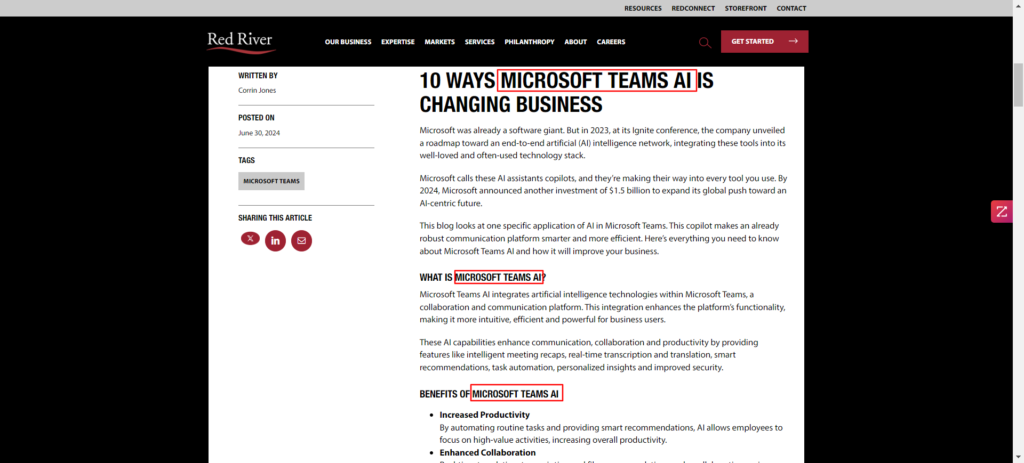Most organizations know the basics of content marketing, like writing blog posts, producing whitepapers, and crafting case studies. However, today’s digital audience expects more than just these standard approaches. As the industry evolves, so must your content strategies. To truly stand out and achieve long-term success, SaaS companies need to advance beyond basic SaaS content marketing practices.
We have covered some key advanced SaaS content marketing strategies in our post that go beyond traditional methods. SaaS companies can improve their content marketing, build better relationships with their audience, boost their brand’s reputation, and drive long-term growth by implementing these strategies.
Create Advanced Buyer Personas
Don’t just focus on job titles. You should find out what your target audience does every day, and what their main challenges and goals are. For example, if you’re targeting IT managers, don’t just know that they work on network security. Understand the specific problems they deal with, like managing more devices or handling cybersecurity threats. Such detailed understanding allows you to create content that directly addresses their needs and problems.
You must identify and understand how your target customers make purchasing decisions.
- The Buying Journey: Track the stages from problem recognition to final purchase. Find out the steps they take and the kind of information they seek at each stage.
- Influencers and Gatekeepers: Determine who else (for instance, team members, executives, or external consultants) is involved in the decision-making process besides the primary decision-maker.
Instead of just identifying generic pain points, such as a lack of efficiency, you must explore:
- Underlying Challenges: What are the root causes of these issues? For example, is the lack of efficiency due to outdated technology, inefficient workflows, or skill gaps?
Emotional Triggers: Understand the emotional aspects of their pain points, and how these challenges impact their stress levels, job satisfaction, or work-life balance.
You must determine how your audience behaves online and interacts with content – the types of content (like blogs, videos, infographics, or podcasts) they engage with most and where they spend their time (LinkedIn or other social media, industry forums, or niche communities).
Leverage Advanced Data Analytics
Basic analytics like page views and click-through rates are just the starting point. To truly understand your content’s impact, you should integrate advanced data analytics:
- Customer Segmentation: Analyze your audience data to identify distinct segments based on behavior, interests, and demographics. Customer segmentation lets you create targeted content that resonates with different groups.
- Attribution Modeling: Track how various pieces of content contribute to a customer’s journey and conversion path. Understanding which content drives the most value allows you to focus on what works best.
- Predictive Analytics: Use data to forecast future trends and user behaviors so that you can anticipate what types of content will be most effective and plan accordingly.
Develop a Content Ecosystem
Rather than creating standalone pieces of content, it is highly recommended to develop an interconnected content ecosystem:
Establish Content Hubs
Content hubs are centralized areas on your website dedicated to key topics that are of significant interest to your audience. You provide one central spot where your audience can find all the information they need about a specific topic.
You can create hubs that cover major themes relevant to your industry or audience’s needs. For example, if you provide marketing automation tools, set up a hub around digital marketing strategies and tactics. Populate these hubs with a variety of content types such as detailed articles, comprehensive guides, infographics, and related blog posts. Ensure these resources are interconnected, making it easy for visitors to explore related content.
Develop Content Series
It involves creating a sequence of related content pieces that follow a coherent theme or narrative and are released over time. It builds anticipation for future content and helps create a loyal following.
You can plan and produce a series of related content such as monthly webinars, ongoing email courses, or a sequence of blog posts on a specific topic. For instance, you might create a series of blog posts detailing various aspects of using your software effectively.
Implement Cross-Channel Integration
Cross-channel integration ensures that your SaaS content strategy is consistent and coordinated across all platforms and channels. It enhances the visibility and impact of your content by utilizing multiple platforms to connect with a broader audience.
It is advisable to maintain a unified voice, message, and visual style across various channels (like blog, social media platforms, email newsletters, and other communication channels).
Strategically promote your content hubs and series on different platforms. You can share snippets of your content series on social media and link back to your content hubs for more in-depth exploration.
Adopt Interactive Content
Interactive content can significantly boost engagement and provide deeper insights into your audience’s preferences.
You can develop quizzes or assessments that help users identify their needs and guide them to relevant solutions within your SaaS offering. Provide interactive product demos or trials that allow potential customers to experience your software’s capabilities firsthand.

Source: Align
You can also create tools that allow users to estimate potential ROI or savings from using your product.
Personalize Content at Scale
Personalizing content at scale means adjusting your content to fit the needs and interests of each individual user, even when you’re working with a lot of data and a large audience.
Leverage Dynamic Content
Dynamic content changes based on the user’s profile, preferences, or behavior in real time. It gives users content that is directly relevant to them, which makes their experience better.
You can use tools and technologies to show different versions of your content to different users based on their characteristics. For example, show specific product features to users based on their industry or role. Implement automation to adjust content dynamically across various touchpoints such as websites, emails, and in-app messages.
Implement Predictive Personalization
You should analyze historical data to predict future behavior and preferences. For example, if a user frequently interacts with content about onboarding processes, they may be interested in more advanced tutorials. Use recommendation algorithms to suggest relevant content or features to users based on their past interactions.
Use Personalization Tools and Technologies
You should consider using advanced CMS platforms that support dynamic content and personalization features. Integrate CRM systems to manage and analyze customer data, enabling more targeted content delivery.
Optimize for SEO and SEM
To reach your goals and surpass your competitors, make sure your content is easy to find. This can be simply done by optimizing your content for SEO and SEM.
Enhance SEO
Start by identifying relevant keywords and phrases that your potential customers are searching for. Google Keyword Planner and SEMrush are some effective tools that you should definitely try to find keywords that are relevant to what you offer.

Source: Red River
Integrate these keywords naturally into your content, including titles, headings, meta descriptions, and body text. Your content should include clear headings and sub-headings and be well-organized throughout.
Improve your site’s loading speed, make sure it works well on mobile devices, and use secure connections (HTTPS). Ensure that search engines can crawl and index your pages effectively.
Generate backlinks from reputable websites to increase your content’s authority and improve its search engine ranking.
Optimize SEM

Source: Pro-Vigil
You should create targeted ads using platforms like Google Ads. Choose relevant keywords and craft compelling ad copy to attract clicks.
Ensure that the landing pages your ads direct users to are well-optimized for conversions. They should be relevant to the ad, load quickly, and provide a clear call to action.
Utilize ad extensions to provide additional information, such as site links, phone numbers, or addresses, which can improve your ad’s visibility and click-through rate.
Final Thoughts
While mastering the basics of SaaS content marketing is essential, advancing to these more sophisticated SaaS content marketing strategies can help SaaS companies create a more impactful and engaging content experience.
You should regularly test different content formats, headlines, and CTAs to determine what resonates best with your audience. Collecting and analyzing feedback from your audience is crucial for improving your SaaS content strategy and fixing any issues. You can use insights from analytics and feedback to continually refine your content approach, ensuring it remains relevant and effective.
Author Bio





